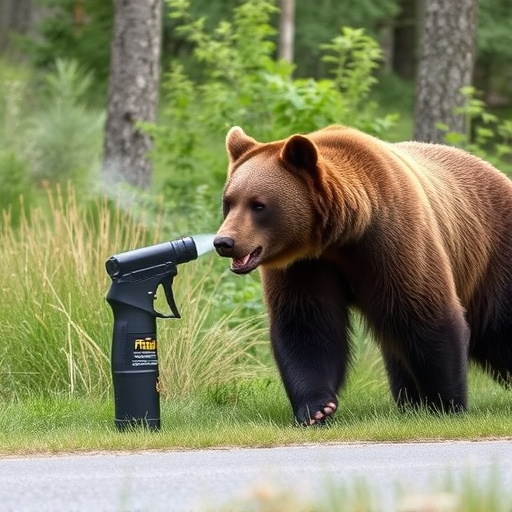Backpacking through stunning national parks comes with an inherent sense of adventure, but also potential risks. One often-overlooked essential for safety is bear spray—a powerful tool that can deter aggressive bears and save lives. This guide explores bear spray as a lifesaving measure for outdoor enthusiasts, delving into its effectiveness, legal considerations at national parks, and crucial gear choices. We’ll navigate the best practices for carrying and using bear spray during backpacking trips, ensuring you’re prepared to face the great outdoors with confidence.
- Understanding Bear Spray: A Lifesaving Tool for Outdoor Enthusiasts
- Bear Spray Laws in National Parks: What You Need to Know
- Choosing the Right Bear Spray Safety Gear: Features and Considerations
- Best Practices for Carrying and Using Bear Spray During Backpacking Adventures
Understanding Bear Spray: A Lifesaving Tool for Outdoor Enthusiasts
Bear spray is a crucial safety gear for outdoor enthusiasts navigating remote areas, especially in national parks where bear encounters are common. It’s a powerful deterrent that can provide precious time and space to escape potentially dangerous situations. Understanding how to use it effectively and being aware of local bear spray laws in various national parks is essential for a safe adventure.
Bear spray works by creating a barrier between you and the bear, temporarily blinding and disorienting it. When sprayed, the irritants can cause bears to alter their behavior, allowing adventurers a chance to retreat or find safety. However, proper usage depends on proximity and wind direction, making knowledge of local guidelines vital. Different national parks may have specific regulations regarding bear spray types, capacities, and application techniques, so it’s critical for visitors to familiarize themselves with these rules before heading into the wilderness.
Bear Spray Laws in National Parks: What You Need to Know
In many national parks across the globe, carrying bear spray is mandatory for visitors due to stringent bear spray laws aimed at ensuring visitor safety. These regulations vary from park to park, but they generally outline specific guidelines on types of sprays allowed, permitted usage, and storage requirements. Understanding these rules is crucial before setting out on a backpacking adventure in these areas.
National parks often have strict protocols to manage potential encounters with bears, and bear spray is recognized as an effective deterrent. Bear spray laws typically specify the minimum strength required, often measuring in SCU (spray concentration units), and may prohibit the use of homemade or non-approved sprays. Park rangers educate visitors on safe handling, usage techniques, and the importance of following instructions to ensure maximum effectiveness during a bear encounter.
Choosing the Right Bear Spray Safety Gear: Features and Considerations
When venturing into wilderness areas, especially national parks where bear spray laws are in place, selecting the appropriate safety gear is paramount. The key component here is, of course, a reliable bear spray can. Look for products that meet industry standards and offer a good range and concentration of pepper spray. Consider factors like the distance it can reach, wind resistance, and ease of use – especially if you’re less familiar with bear spray.
Additionally, your safety doesn’t solely rest in the spray itself. The gear should also include a durable carrier or belt for easy access, as well as reflective components to enhance visibility during low-light conditions. Some models come with holsters or clips that allow you to attach the spray to your clothing, ensuring it’s always within reach. Familiarize yourself with local bear spray laws in national parks and practice using the gear before setting out on your adventure.
Best Practices for Carrying and Using Bear Spray During Backpacking Adventures
When backpacking in areas where bears roam, proper storage and handling of bear spray is essential. Always store your bear spray in an easily accessible yet secure location on your person or backpack. Keep it outside of your sleeping quarters and away from food sources to prevent accidental discharge or unauthorized access. Remember that different national parks have varying regulations regarding bear spray, so familiarize yourself with local laws before setting out.
Using bear spray effectively requires understanding the recommended distance and angle for application. Typically, you should aim for a target about the size of a human head at a distance of 20-30 feet. Spray in short bursts, approximately 1-2 seconds, and move away quickly after discharge to minimize the risk of bear contact. Keep in mind that bear spray is not a substitute for good wilderness safety practices; always make noise while hiking through known bear country, travel in groups, and store food securely to reduce potential conflicts with bears.
When embarking on backpacking adventures in national parks, understanding bear spray laws and the proper usage of this safety gear is paramount. By choosing the right equipment, knowing local regulations, and mastering best practices, outdoor enthusiasts can effectively navigate potential bear encounters and ensure a safe and memorable trip. Remember, preparation and knowledge are key to enjoying nature’s wonders without compromising your well-being.
